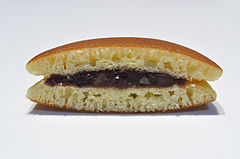Dorayaki
 | |
| Alternative names | Mikasa |
|---|---|
| Type | Wagashi pancake |
| Place of origin | Japan |
| Main ingredients | Castella, red bean paste or sweet azuki bean paste |
This article needs additional citations for verification. (June 2008) |

Dorayaki (どら焼き, どらやき, 銅鑼焼き, ドラ焼き) is a type of Japanese confection. It consists of two small pancake-like patties made from castella wrapped around a filling of sweet azuki bean paste.[1][2]
The original dorayaki consisted of only one layer. Its current shape was invented in 1914 by Usagiya in the Ueno district of Tokyo.[3]
In Japanese, dora means "gong" and the name reflects the original dorayaki was baked (yaki) on a heated gong, the Kyoto based confectionery Sasaya Iori states, claiming they invented dorayaki in request from Toji Temple[1].
There is however a rumor it is probably the origin of the name of the sweet.[2][3] Legend has it that the first dorayaki were made when a samurai named Benkei forgot his gong (dora) upon leaving a farmer's home where he was hiding, and the farmer subsequently used the gong to fry the pancakes.[3]
Azuki bean paste[4] is normally used by itself, but chestnuts[5] and rice cakes[6] are sometimes added. There are also Dorayaki with amanatto[7].
Other varieties include "Pudding Dorayaki" with pudding[8] sandwiched in between, "Fruit Dorayaki", a Dorayaki with fruit as the main ingredient, "Parfait Dorayaki" a hearty Dorayaki that looks as if a parfait[9] had been placed inside the Dorayaki.
Regional variation
[edit]In the Kansai area, this sweet is often called mikasa (三笠). The word originally means triple straw hat, but is also an alternative name of Mount Wakakusa, a low hill with gentle slopes located in Nara. In Nara, a larger mikasa of about 30 cm in diameter is made.[10]
In popular culture
[edit]The Japanese manga and anime character Doraemon loves dorayaki and so it is depicted as his favourite food (in the English dub, Nobita (Noby in English) calls it "yummy buns" as an alternative), and it has been a plot device several times throughout the series. Doraemon is addicted to dorayaki and falls for any trap involving them. Since 2000, the company Bunmeido has been selling a limited version of dorayaki called Doraemon Dorayaki every year around March and September. Since 2015, JFC International has produced Doraemon Dorayaki for the North American market.
In 2015 filmmaker Naomi Kawase released the film "An" ("Sweet Bean"), based on a novel, Sweet Bean Paste, by Durian Sukegawa, about an elderly woman who has a secret recipe for dorayaki anko.[11][12][13]
See also
[edit]- Japonesa - a similar confection eaten in Spain and Gibraltar
- Apam balik - a pancake-like confection in Malaysia, Indonesia, Brunei and Singapore
- Chalbori-ppang - a similar confection originating in Korea
References
[edit]- ^ "Dori-yaki: Bon Appetit!". NIPPONIA No. 40. Web Japan.
- ^ a b Yoshizuka, Setsuko. "Dorayaki". About.com Japanese Food. Archived from the original on 4 February 2012. Retrieved 24 February 2012.
- ^ a b c "Food to Try at HYPER JAPAN: Dorayaki". Gaijin Gourmet. London, UK: Eat-Japan. August 19, 2010. Archived from the original on November 20, 2010. Retrieved 24 February 2012.
- ^ "Red bean paste", Wikipedia, 2024-07-30, retrieved 2024-11-17
- ^ "Chestnut", Wikipedia, 2024-11-17, retrieved 2024-11-17
- ^ "Rice cake", Wikipedia, 2024-11-13, retrieved 2024-11-17
- ^ "Amanattō", Wikipedia, 2024-11-13, retrieved 2024-11-17
- ^ "Pudding", Wikipedia, 2024-11-08, retrieved 2024-11-17
- ^ "Parfait", Wikipedia, 2024-09-22, retrieved 2024-11-17
- ^ Blankestijn, Ad. "Monaka & Dorayaki". Japanese Food Dictionary. Archived from the original on 20 November 2010. Retrieved 24 February 2012.
- ^ Lodge, Guy (14 May 2015). "Film Review: 'An'". Variety.com. Retrieved 21 December 2017.
- ^ "映画『あん』". 映画『あん』オフィシャルサイト. Retrieved 21 December 2017.
- ^ "Sweet Bean Paste by Durian Sukegawa review – a bittersweet confection about prejudice and friendship". 2017.
External links
[edit]- About.com's dorayaki recipe Archived 2014-07-12 at the Wayback Machine
- How to make Dorayaki Archived 2014-06-18 at the Wayback Machine
